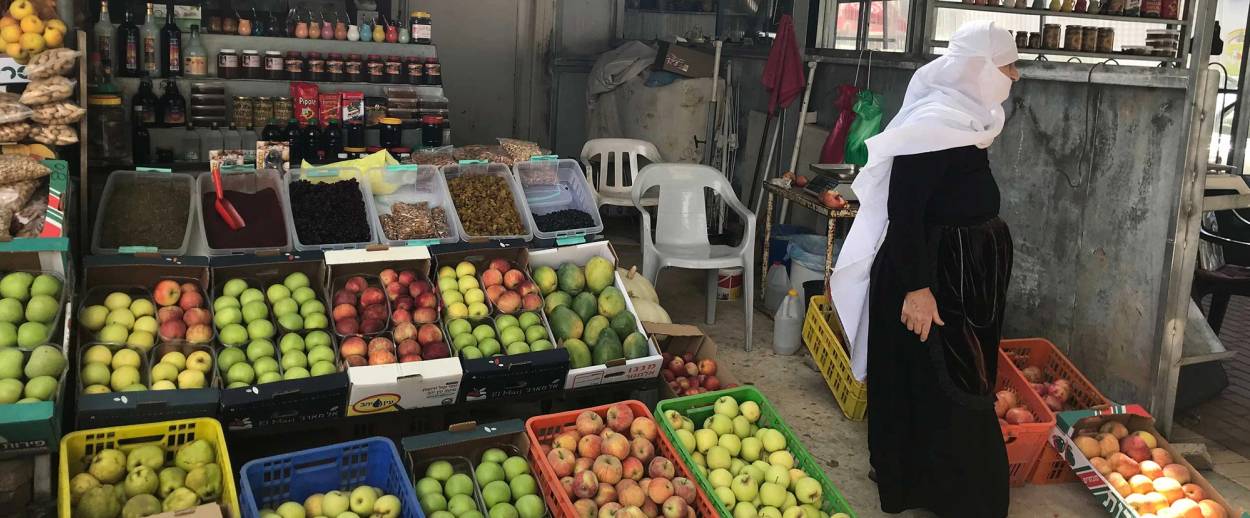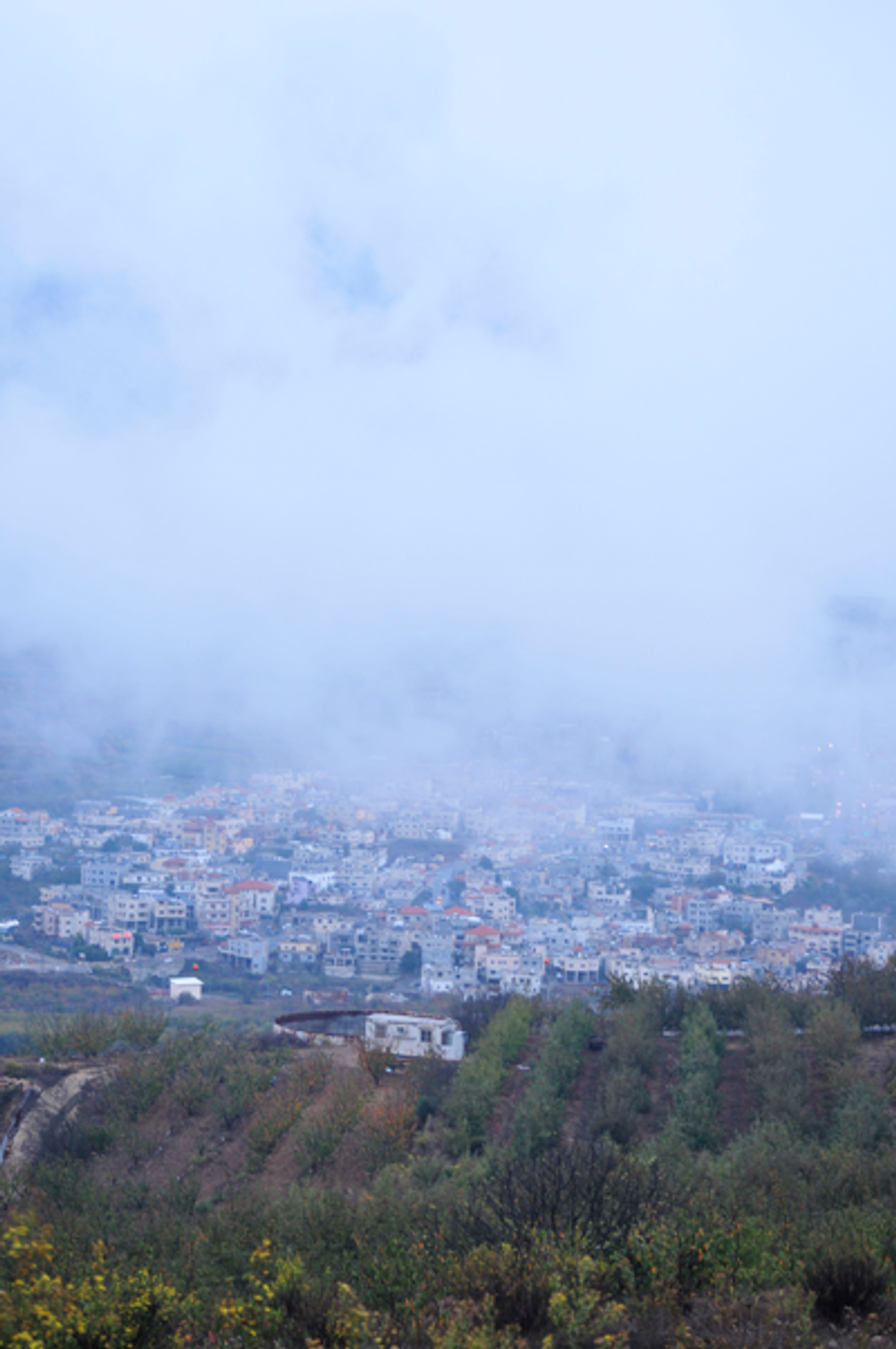A Taste of Druze Cuisine
Food tours in the Golan expand Israeli menus




Israel has the third largest Druze population in the world, after Syria and Lebanon. By the latest estimate, there are approximately 143,000 members of this unique religious and ethnic group in Israel—mostly in the north, particularly in the Galilee and the Golan Heights, with some also living around Haifa. For many Israeli Jews, Druze religion and culture is a bit of a mystery. But Druze food is widely known and beloved.
After having fallen in love with the giant Druze pitot, filled with labneh (strained yogurt) and tabbouleh, sold at any Tel Aviv food market by women in traditional Druze garb, I decided to venture to the north of Israel this fall to get a closer look—and taste. I joined a culinary tour of the Druze villages of the northern part of the Golan Heights, led by Efrat Moskovich.
Moskovich is a graphic designer and food blogger, and founder of the Hebrew-language blog How to Impress Your Mother-in-Law). She lives in Moshav Yonatan in the Golan Heights and did her first tour in the area just for her friends. But they loved it so much that she turned it into a business: Now Moskovich leads tours about twice a month (in Hebrew only), each one including up to 20 people, most of whom are Israeli Jews.
“We are neighbors,” Moskovich told me when I asked about her relationship to the Druze community. “I know many Druze, our family doctor is Druze. Living in the Golan, we live together and we work together and I am fascinated by their culture and food—that’s why I decided to build a tour that shows people the wonders of the Druze cuisine in this area.”

On our tour we visited the four remaining Druze settlements in the Israeli-occupied portion of the Golan Heights—Majdal Shams, Mas’ade, Buq’ata, and Ein Qiniyye—whose population altogether is about 23,000. While the Druze of the Galilee are Israeli citizens and serve in the Israeli army, the majority of Druze in the Golan Heights adopted permanent residency but refuse Israeli citizenship, and instead retain Syrian citizenship.
Our first station was Naseba Samara’s place in Buq’ata. It’s not a restaurant as such, but more of a cultural center in which Samara—a local entrepreneur and raconteur—welcomes groups for traditional Druze home cooking, as well as stories about her culture. She welcomes families and groups from all over the world—Israelis as well as tourists. Visitors can book a whole event, like the one Moskovich took her group to, or can order takeout or eat there, providing the place isn’t fully booked.
For lunch we had two kinds of fatayer (a savory stuffed pastry), one with spinach and one with potatoes; mujaddara (a rice and lentil dish); and grape leaves stuffed with rice, among other dishes. This particular tour was vegetarian, to suit its guests. Had it not been, we might have sampled maqluba (a rice and meat dish served upside-down), kubbeh (bulgur patties stuffed with meat), and other local meat dishes as well.
After lunch, we moved into Samara’s parlor, where she and others told us of local culture. She told us of her groundbreaking business endeavors as a woman in conservative Druze society, about the Shouting Hill (a hill in Majdal Shams where people used to talk to their relatives on the Syrian-controlled side using megaphones, before the advent of video chats), and about the Druze belief in reincarnation. Her friend Jamila’s 4-year-old grandson is something of an Israeli celebrity since a TV documentary revealed that he didn’t talk until he was 2 years old, and suddenly, instead of Arabic, he started speaking fluent English with a distinct British accent, while none of his family understood him. Jamila came over and told us about her grandson, whose family believes he was British in a previous lifetime. Samara and her friends told us stories while everybody passed around a cup of mate with a little metal straw.
Mate (yerba mate tea) is a South American infused drink that Druze communities in Syria, Lebanon, and the Golan Heights consume daily, as part of a social tradition. The custom started when Syrians and Lebanese who moved to Argentina during the 19th century discovered it and brought it back home. The first thing guests are offered when entering a Druze home in the Golan is mate, which the hosts and guests share from the same cup. As Samara explained, it is an integral part of the Golan Druze’s lifestyle, as we could clearly see on our next station: the Druze farmer’s market next to Nabi Ya’furi—the tomb of a Druze holy man called Ya’furi. The market is just a small row of little stands selling local produce, homemade honey and fig jam, spices, pickled baby eggplants stuffed with nuts, labneh balls in olive oil, and of course mate and mate paraphernalia.

“There are certain things that are specific to the Druze of the area that can’t be obtained at the moment,” Moskovich explained. “At other times you would have found them at the market. For instance, honey that is made of the ferula plant. Parts of the plant are poisonous but its honey is delicious and it is said to be helpful for men of a certain age. The plant grows on the summit of the Hermon, on the Syrian side, and at the moment the Druze villages on the Israeli side can’t obtain it because of the situation in Syria.”
After the market we headed to Majdal Shams—a (more) modern Druze town at the foot of Mount Hermon—which Samara jokingly referred to as the Tel Aviv of the Druze. Majdal Shams is less conservative and religious than the Druze villages located farther down the mountain. In Majdal Shams we visited Said Ibrahim’s mill and learned how he makes bulgur and freekeh (a dish made out of green durum wheat) and also learned about kishk—a fermented milk product, like a powdery cereal, which is easily stored and thus an integral part of the winter diet in the area. The Druze in the Golan make it out of bulgur with yogurt from goat’s milk. After it is dried, villagers bring it to Ibrahim to grind into a powder. “In the winter it’s very cold in the villages in the Mount Hermon area,” Moskovich explained. “It snows here and the Druze use the kishk as a base to make soups which they eat for breakfast when it’s cold.”
Out last station, also in Majdal Shams, was Abu Jabel’s knafeh factory, where we participated in a knafeh workshop and made our own delicious Arab pastry, in which two layers of kadaif noodles are filled with soft white cheese, cooked on the stove, drenched in sugar syrup and sprinkled with ground pistachio nuts.
The Druze are an Arabic-speaking ethnic group that splintered from Islam approximately 1,000 years ago. Druze cuisine is basically Arab and Middle Eastern cuisine, with local varieties depending on local produce and customs. The Druze of the Golan, for instance, cook Syrian food with a local twist, by using plants that grow in their area, such as Tournefort’s gundelia.

Many of the foods we sampled on our tour are familiar to Israelis from Arab restaurants, which are not necessarily Druze. “The Druze cook with local and seasonal ingredients,” Amir Khalfon, chef of Carmel Forest Spa Resort, told me. “When it’s the khubeza season, thy cook with khubeza. When it’s the za’atar season they use za’atar. They cook recipes that run in their families for generations, from the region that they came from. Each region has its own nuances, and the region matters more than the fact that they are Druze. The Druze cuisine does not differ that much from other Arab cooking, what matters is the region they came from and the region they live in.”
The Northern and Haifa districts hold many authentic Druze restaurants, like Nora’s Kitchen in Daliyat El Karmel (a Druze town in the Haifa District) or Mitbach HaShvil in Peki’in in the Upper Galilee. By comparison, Druze restaurants catering to outsiders are less prevalent in the Golan Heights. “In the Golan you have restaurants in which you can eat shish kebab, hummus, and french fries—that sort of thing—but not a lot of real authentic home style Druze cooking,” Moskovich concluded. “Druze culture in the Golan is more closed off. They haven’t opened themselves up to tourism as much and they generally keep their culinary delicacies to themselves.”
Always a pioneer, Naseba Samara is all for opening local cuisine up. “Our local food is very special,” she proudly told me, noting that she has hosted groups from as far away as Germany and China. “It’s an honor for me to share this special food with the world.”
***
Like this article? Sign up for our Daily Digest to get Tablet magazine’s new content in your inbox each morning.
Dana Kessler has written for Maariv, Haaretz, Yediot Aharonot, and other Israeli publications. She is based in Tel Aviv.